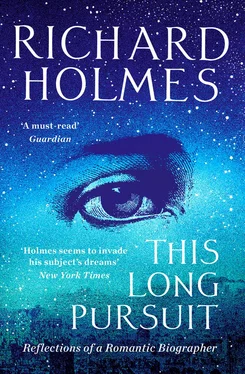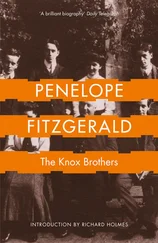Accordingly, my next pursuit, in the service of the poet Samuel Taylor Coleridge, lasted, on and off, for nearly fifteen years and progressed through some thirty two-sided notebooks. It took me to the English West Country and Lake District, to Germany, to Italy, to Sicily, to Malta, and finally to a quiet garden on Highgate Hill in London. It ended in nine hundred pages over two volumes. We both aged considerably in the process.
Coleridge was himself the master of the notebook – over seventy of them survive, thanks to the life’s work of the Canadian scholar Kathleen Coburn. The first was begun in Bristol in 1794, when he was twenty-one; the last was left incomplete at his death in Highgate in 1834. They provide a wonderful underground river for the biographer, an entry into Coleridge’s mind and heart, his inner life, not least in his relations with William and Dorothy Wordsworth, and his secret beloved or femme fatale , his ‘Asra’, Sara Hutchinson.
The notebooks are as multifarious, elusive and incorrigible as the man. They contain his fantastic reading lists, his extraordinary nightmares, his brilliant lecture notes, his hectic fell-walking diaries, his endless self-psychoanalysis sessions, his battles with opium addiction, his excruciating medical symptoms (teeth, lungs, bowels), his sexual hauntings and obsessions, his labyrinthine thoughts about science and religion, his ghastly puns and his moving prayers.
They are also full of wonderful oddities: the draft of a comic novel, the recipe for making waterproof shoe polish, accounts of erotic dreams (partially in Greek and usually connected with food), the sayings of his child Hartley, notes on the sounds of different birdsong, or observations on different kinds and modalities of rainfall. All the time, like the underground river of ‘Kubla Khan’, there is a continual bubbling up of images that would appear in both his poetry and his later criticism; but also a continuous stream of self-definition.
I remember discovering, like a sudden gold-strike, this description of a tiny waterfall on the River Greta, which he wrote when he first came to the Lake District in 1800: ‘Shootings of water threads down the slope of the huge green stone … The white Eddy-rose that blossomed up against the Stream in the scollop, by fits and starts, Obstinate in resurrection – It is the Life that we live.’
It instantly struck me that Coleridge was describing himself – ‘obstinate in resurrection’. Now I can never see a stream flowing over a stone, with that bubbling backwash of foam (so brilliantly defined as the ‘eddy-rose’), without thinking of his biography. There is his complex, mysterious and in many ways disastrous life, which was nevertheless perpetually renewed, miraculously foaming back in words, ‘obstinate in resurrection’. It was indeed the life that he lived. I gradually realised it was also the Life that I needed to write.
Coleridge’s travels were geographical as well as metaphysical, and true to the Footsteps principle I followed him faithfully. In exchange, Coleridge taught me many lessons about biography during these research trips or solitary pursuits. I followed his walk over the wild Quantock Hills and down to the tiny seaport at Watchet where he began The Ancient Mariner with Wordsworth in 1797. Here the Bristol Channel surges out towards the Atlantic, producing one of the most astonishing tidal swings in the whole of northern Europe, rising and falling over thirty feet in twelve hours. Watching the fishing boats locked in its muscular grasp, I understood something new about the submarine ‘Polar Spirit’ of the deep, that pursued the Mariner after he had killed the albatross; and more than that, something of the huge tides that had always swept through Coleridge’s own life.
I went out to Göttingen in Germany, where he had attended the scientific lectures of Johann Friedrich Blumenbach in 1799, read the Naturphilosophie of Friedrich Schelling, from which his own ideas about Nature, Form and the Unconscious would eventually develop in ‘genial coincidence’. He became fascinated by the story of the Walpurgisnacht (or Witching Night) on the nearby Brocken mountain, which later appears in Goethe’s Faust (1808). Typically, Coleridge had climbed the Brocken to interview the legendary ‘Brocken spectre’ for himself, in a mixed spirit of scientific and poetic enquiry. Clambering up after him through the dark colonnades of the Hartz forest, I came across a different kind of witchcraft.
Panting up through a clearing of pine trees, I burst upon a sort of surreal Faustian theatre set. It was decked with skull-like signs announcing ‘ Halt! Hier Grenze! ’, and promising imminent death. I had stumbled upon the huge, sinister double border fence, sown with landmines and automatic machine-guns, dividing East and West Germany. Like the moment twenty years before, when, naïvely retracing Robert Louis Stevenson’s Travels with a Donkey in the Cévennes , I had come down to his symbolic river bridge at Langogne, and to my profound dismay found that it was broken and impassable, his time literally divided from my time. This was another sharp lesson in the irrecoverability of the past.
Another trip took me to Malta, where, in the unlikely role of wartime civil service secretary, Coleridge promulgated by-laws, visited military hospitals (appalled by the syphilitic cases, several to a bed), wrote political propaganda, and clean-copied the last despatches from Governor Admiral Ball to Nelson before the Battle of Trafalgar.
His shape-shifting during this period, 1804–05, is extraordinary, yet characteristic. At Valletta, I found that his lonely rooms in the Governor’s Palace directly overlooked the harbour. Having borrowed a naval telescope, the bustling secretary somehow disappeared for hours, studying the many ships arriving and departing, dosing his homesickness with opium and erotic poetry, and writing learned notes on ‘organic form’.
It was here I found Coleridge unexpectedly praying to the moon. His strange, metaphysical account of ‘Sabaism’, or sun- and moon-worship, had previously gone unnoticed. But it told me something crucial about his religious beliefs, always suspended – ‘a willing suspension of disbelief’ – between a punishing Christianity and pure, exhilarating Pantheism. It also reminded me how central the moon is to all his poetry, from The Ancient Mariner to ‘Limbo’.
In looking at objects of Nature while I am thinking, as at yonder Moon dim-glimmering through the dewy window-pane, I seem rather to be seeking, as it were asking , a symbolical language for something within me that already and forever exists … the dim Awaking of a forgotten or hidden Truth of my inner Nature … the Creator! the Evolver!
Back in England, I located the little lost house in Calne, Wiltshire, opposite the churchyard, where he went to ground in 1813, given up by almost all his friends – even by Wordsworth – as a hopeless opium addict who would achieve nothing. On the hillside above his house I saw the symbolic Cherhill White Horse, carved in the chalk around 1780, galloping towards London, which always gave him hope. Two years later he re-emerged with a draft of his prose masterpiece the Biographia Literaria , a fantastic mixture of humorous autobiography, brilliant psychological criticism, and plagiarised German philosophy. So much of this, like his lectures, is best read in fragments. For instance this inspired lecture note – a mere four words – summarising the opening of Shakespeare’s Hamlet . ‘Suppression prepares for Overflow.’ I came to think that this contained, or rather anticipated, all Freud.
Yet some of the most vivid lessons came from his childhood at Ottery St Mary in Devon, which reappears in so many of his best early poems, like the ‘Sonnet to the River Otter’ and ‘Frost at Midnight’. In the sonnet, he explores the infinitely subtle shifts of feeling between the immediate experience of the child and the recollections of the adult. The recreation of this movement remains one of the greatest challenges to biographical narrative. Coleridge succeeds in catching it with wonderful simplicity, using the stone-skimming children’s game of ducks and drakes, and the ‘bedded sand’ of memory:
Читать дальше












